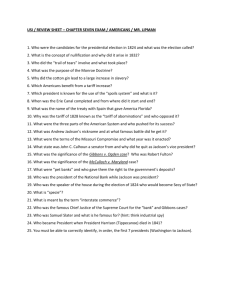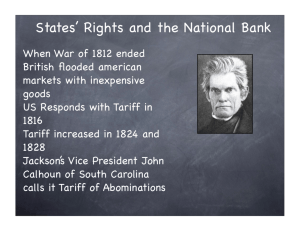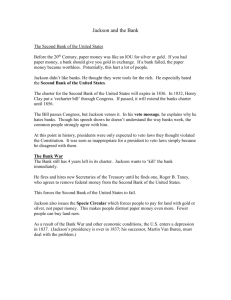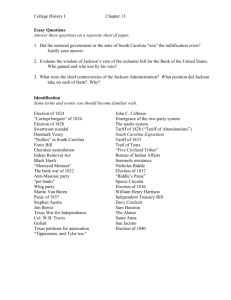Chapter 7 * Balancing Nationalism and Sectionalism
advertisement
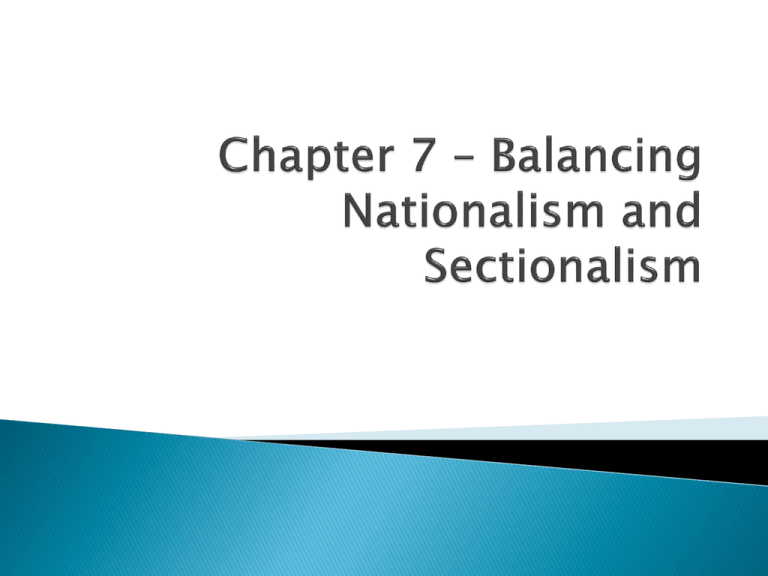
Better tools sped up the manufacture of goods and improved their reliability. Inventions and ideas such as these would affect different regions of the young nation in different ways. Eli Whitney developed interchangeable parts New approaches to manufacturing took industry out of American households and artisans’ workshops and made factories the new centers of industry Mass production – the production of goods in large quantities Industrial Revolution – social and economic reorganization that took place as machines replaced hand tools and large-scale factory production developed Great Britain Starts a Revolution ◦ Industrial Revolution began in Britain during the 18th century ◦ Inventors came up with ways to generate power using swiftly flowing streams and supplies of coal The Industrial Revolution in the United States ◦ After the American Revolution, international trade, not manufacturing was the main source of income ◦ The Embargo Act of 1807 and the War of 1812 made Americans develop domestic industries so we would not rely on others for income New England Industrializes ◦ Due to agriculture in the region not being highly profitable ◦ Samuel Slater (British immigrant) started textile factory in 1793 in Rhode Island – then many started to follow Agriculture in the North ◦ Type of land and the growth of cities in the North encouraged farmers to cultivate smaller farms than Southerners did, and to grow crops that did not require much labor ◦ As cities grew, farmers realized they could grow “extras” at city markets so they could purchase other things they needed ◦ By the late 1700s, slavery in the North was dying out due to little economic motivation, Northerners began to voice their religious and political opposition to slavery Cotton is King in the South ◦ Eli Whitney invented in the cotton gin in 1793 had helped set the South on a different course of development than the North ◦ Cotton was in great demand in Britain and in the North so Southerners needed to grow large amounts ◦ 1820 – plantation system was developed and plantation owners needed workers – economic motivation to have a large amounts of slavery Slavery becomes Entrenched ◦ Even though slave importation declined, the need for slaves increased greatly in the 1820s As the North and South developed different economies, the creation of a plan to unify the nation became increasingly important 1815 – President Madison Proposed: ◦ Develop transportation systems and other internal improvements ◦ Establish a protective tariff ◦ Resurrect the national bank House Speaker Henry Clay began to promote this as the American System – he and others believed that with each part of the country sustaining the other, Americans would finally be economically independent of Britain and other European nations. Erie Canal and Other Internal Improvements ◦ For people in different regions to do business with one another and for the economy to grow, they had to communicate, travel, and transport goods. Railroads Canals Roads ◦ Many states built turnpikes and the federal government wanted to build a National Road to connect different regions ◦ 1825 – Erie Canal linked the Hudson River to Erie Lake Tariffs and the National Bank ◦ Placing a tariff on imports would increase the cost of foreign goods and thereby eliminate their price advantage. ◦ Tariff revenues would help pay for internal improvements so President James Madison proposed the Tariff of 1816 North approved; South and West did not approve ◦ Second Bank would make available a currency guaranteed to be accepted nationwide Nationalism – loyalty to one’s country Gibbons v. Ogden – 1824 – helped to ensure that the federal government has the power to regulate just about everything that crosses state lines. Strengthening Government Economic Control Limiting State Powers ◦ McCulloch v. Maryland – 1819 – supported the federal governments over the state governments – defined the power of the Court to determine whether acts of Congress or the president violated the Constitution ◦ Fletcher v. Peck – 1810 – the Court nullified a Georgia law that had violated individuals’ constitutional right to enter into contracts ◦ Dartmouth College v. Woodward – 1819 – the Court declared that the state of New Hampshire could not revise the original charter it had granted to the college’s trustees in colonial times ◦ Charter – a contract, the Court said, and the Constitution did not permit states to interfere with contracts Territories and Boundaries The Monroe Doctrine ◦ John Quincy Adams prioritized the security of the nation and expansion of its territory ◦ Rush-Bagot Treaty – 1817 – US and Canada completely demilitarize their common border ◦ Convention of 1818 – fixed the US border at the 49th parallel up to the Rocky Mountains ◦ Adams-Onis Treaty – Spain gave up Florida and its claims to the Oregon Territory ◦ European powers wanted to reclaim their former colonies in Latin America ◦ With Spain and Portugal trying to move back into their old colonial areas, and with Russia pushing in from the northwest, the US knew it had to do something. ◦ Monroe Doctrine President Monroe warned all outside powers not to interfere with affairs in the Western Hemisphere US would consider such action “dangerous to our peace and safety” US would not involve itself in European affairs or interfere with existing colonies in the Western Hemisphere Expansion to the West The Missouri Compromise ◦ Some settlers went west to escape debts or even the law, most pushed westward in search of economic gain – for land was not only plentiful and fertile but cheap ◦ When a territory’s population reached about 60,000, the people of the territory could petition the Union for admission, draft a state constitution, elect representatives, and become part of the US, once Congress approved ◦ 1819 – settlers in Missouri requested admission into the Union, but a conflict arose – the conflict of slavery North and South wanted the states to be equal in regards to slavery – at the time we had 11 free states and 11 slave states – adding Missouri would cause it not to be balanced Missouri Compromise – 1820 - Maine would be added as a free state, Missouri as a slave state – rest of the Louisiana Territory was split into two spheres of interest, one for slaveholders and one for free states ** Thomas Jefferson was among those who feared the Union’s future after the Missouri Compromise With Adams’s and Jefferson’s deaths in 1826, 50 years after the Declaration of Independent had been approved by delegates, the presidency belonged to another generation Tension between Adams and Jackson ◦ Election of 1824 – Andrew Jackson won the popular vote but lacked the majority of electoral votes. Since no candidate had received a majority of the votes of the electoral college, House of Representatives had to decide the outcome – John Quincy Adams had won ◦ Jacksonians accused Adams of stealing the presidency and struck a corrupt bargain Democracy and Citizenship ◦ During Adam’s presidency, most states eased the voting requirements, thereby enlarging the voting population ◦ However, women and Free African Americans did not enjoy the political freedoms of white males Jackson’s Appeal to the Common Citizen ◦ Election of 1828 – Jackson portrayed himself as a man of humble origins, even though he was actually a wealthy plantation owner – he won the election by a landslide Jackson’s Spoils System ◦ Spoils System – incoming officials throw out former appointees and replace them with their own friends Jackson fired nearly 10% of the federal employees and gave their jobs to loyal Jacksonians Two attitudes towards Native Americans Indian Removal Act of 1830 ◦ Displacement and dispossession of all Native Americans ◦ Convert Native Americans to Christianity, turn them into farmers, and absorb them into the white culture ◦ Jackson thought assimilation could not work ◦ Jackson thought allowing Native Americans to live in their original areas would have required too many troops to keep the areas free of white settlers – about 90 treaties were signed ◦ Jackson thought the only solution was to move the Native Americans from their lands to areas farther west – Congress Passed the Indian Removal Act in 1830 – federal government funded negotiation of treaties that would force the Native Americans to move west – at times we sent in troops to force Indians to move The Cherokee Fight Back Trail of Tears ◦ Worcester v. Georgia – 1832 – Cherokee Nation finally won recognition as a distinct political community. The Court ruled that Georgia was not entitled to regulate the Cherokee nor to invade their lands. ◦ Jackson refused to abide by the Supreme Court decision and continued to try and move the Native Americans out ◦ Treaty of New Echota – gave the last 8 million acres of Cherokee land to the federal government in exchange for approximately $5 million and land west of the Mississippi – continued forced removal was given by President Martin Van Buren (Jackson’s successor) ◦ 800 mile trip – began in October and November of 1838 ◦ As winter came, more and more Cherokee died en route ◦ Along the way, government officials stole the Cherokee’s money, while outlaws made off with their livestock ◦ This path came to be known as the Trail of Tears because of everything lost by the Cherokee on the way to their new land Daniel Webster and John C. Calhoun began debates in the Senate between state and federal authority The Nullification Theory ◦ Tariff of Abominations – 1828 tariff – high tariff on manufactured goods reduced British exports to the US and forced the South to buy the more expensive Northern manufactured goods ◦ The South thought the North was getting rich at their expense ◦ Calhoun devised a nullification theory stating that each state had the right to nullify (reject) a federal law that it considered unconstitutional. He believed that if the federal government refused to permit a state to nullify federal law, the state had the right to withdraw from the Union. Hayne and Webster Debate States’ Rights South Carolina Rebels ◦ Tariff question and the underlying states’ rights issues was discussed in January 1830 debates between Robert Hayne (South Carolina) and Daniel Webster (Massachusetts) ◦ States’ rights were tested in 1832 when South Carolina did not like the tariffs of 1828 and 1832 and threatened to secede if customs officials tried to collect duties ◦ Jackson was furious and declared South Carolina’s actions treasonous and threatened to hang Calhoun and march federal troops into South Carolina to enforce the tariff ◦ Force Bill of 1833 – allowed the federal government to use the army and navy against South Carolina if state authorities resisted paying proper duties ◦ Henry Clay stepped in and proposed a tariff bill that would gradually lower duties over a 10 year period For now the crisis between states’ rights and federal authority was controlled, but would continue to cause conflict and be a major cause of the Civil War 1832 – Jackson vetoed the bill to recharter the Bank of the United States Jackson Opposes the Bank ◦ Henry Clay and Daniel Webster wanted to introduce the renewal for banks charter to make it a campaign issue ◦ Jackson and his allies made certain that the general public came to think of the Bank of the United States (BUS) as a privileged institution All federal tax revenues were deposited in the BUS rather than state or private banks, BUS had an unfair advantage over other banks BUS stockholders, not average American taxpayers, earned the interest from these deposits Bank’s president often extended loans to congressmen at much lower rates of interest than the bank gave to the average citizen Pet Banks Whig Party Forms ◦ 1832 – Jackson said the BUS was “monster” that corrupted “our statesmen” and wanted “to destroy our republican institution” ◦ Jackson was reelected in 1832 he tried to kill the BUS before its charter ran out in 1836 – he appointed a secretary of the treasury who was willing to place all government funds in certain state banks (pet banks) ◦ Pet Banks – banks that were loyal to the Democratic Party ◦ The Second National Bank’s charter expired and became a state bank and then eventually went out of business ◦ Jackson’s tactics and policies had angered many people ◦ Many channeled their frustrations into action and formed a new political party called the Whig Party Whigs backed the ideals of the American System Whigs wanted to use federal money to construct roads and canals Whigs also baked federal control of the banking system and a nationally accepted currency Jackson’s Legacy ◦ Pet banks printed bank notes wildly in excess of the gold and silver they had on deposit, and were doomed to fail when many people attempted to redeem their currency for gold or silver ◦ Federal government was left holding the bag when people used the notes printed by wildcat banks when purchasing land from the government ◦ Banks stopped accepting all paper currency ◦ Panic of 1837 – bank closings and the collapse of the credit system cost many people their savings, bankrupted hundreds of businesses, and put more than a third of the population out of work ◦ Van Buren tried to help by reducing federal spending and tried to set up an independent treasury that would only use gold and silver coin Harrison and Tyler ◦ William Henry Harrison won the 1840 election by portraying Van Buren as a pampered, privileged aristocrat. ◦ Harrison took steps to enact the Whig Program to revitalize the economy but died a month after taking office of pneumonia and John Tyler took over.

